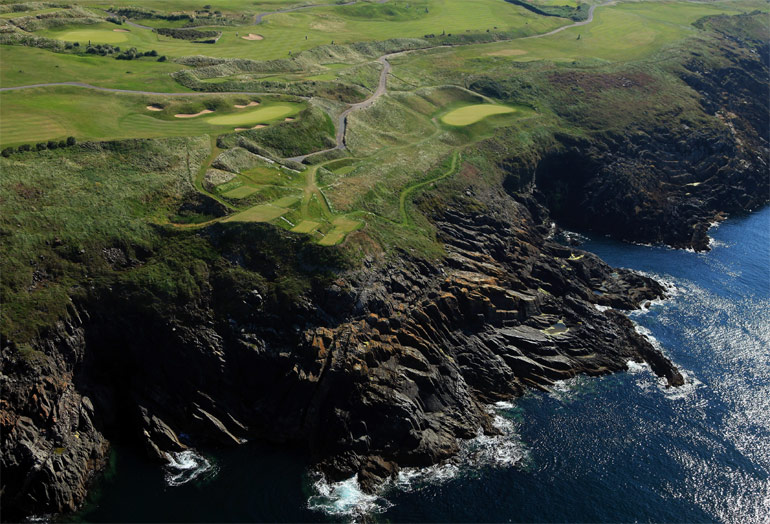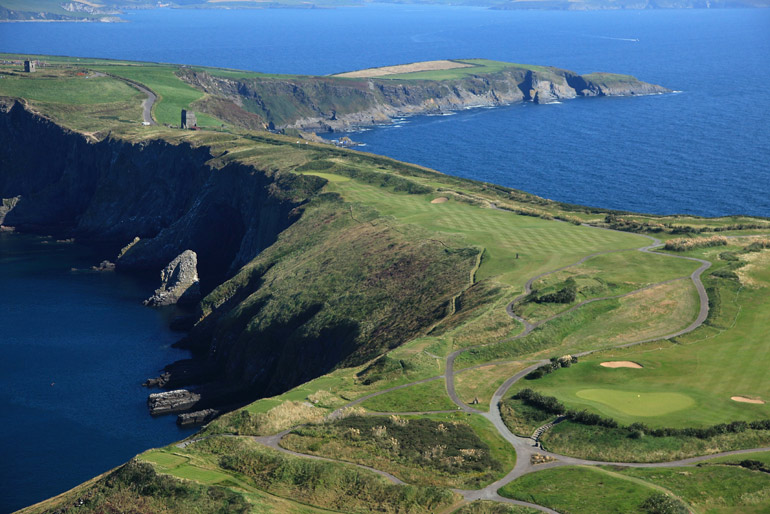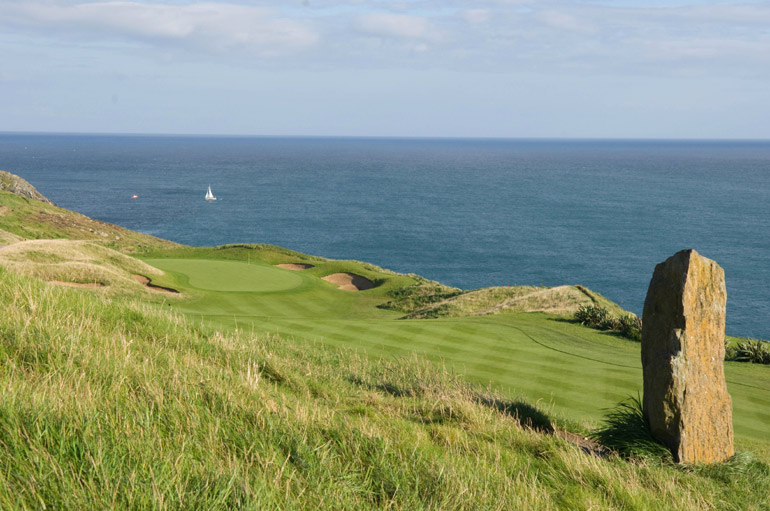![]()
Feature Interview with Danny Brassil
December 2011

Few courses can compete with the setting of Old Head. Above is the fourth hole which doglegs left to a green that sits forty yards farther back than it did on opening day.
Describe the land that Old Head occupies.
The Old Head Golf Links is built on a 220 acre headland that runs 2 miles into Atlantic Ocean. The course and facilities take up 180 acres leaving 40 acres of natural untouched cliffs.in effect the course is located on an island that is connected to the mainland by a spectacular 400 metre “land bridge”. It is perched 300 feet above the ocean offering spectacular views from every hole.
How did John and Patrick O’Connor acquire it?
The property was purchased from a local farmer in the late 1980’s by private treaty.
What kind of permitting issues did they overcome? Were the local and national government entities supportive in general?
Because of its farmland status the Old Head was one of the last courses in Ireland not to require planning permission. However, permission was required for the clubhouse and machinery compounds and a number of onerous conditions were applied by the planning authorities –public access being the main one. These were subsequently challenged by the O’Connor’s and a judicial review ruled against Cork County Council and An Bord Planala. Bord Planala took the case to the High Court and Later to the Supreme Court, both Courts ruled against the Planning Authorities and the contentious conditions were withdrawn.
Could they gain the required support if they were just starting out today? Does recent legislation curtail the hope of future golf courses along the coast of Ireland?
In today’s climate it is certain that planning to build a golf course on the Old Head would be extremely difficult if not impossible. Planning permission for any golf development would be difficult to acquire as any links type project would be strenuously opposed.
Old Head opened for play in 1999. Who was the architect? Who performed the construction?
A number of individuals were involved in the design. Ron Kirby, Eddie Hackett, Paddy Merrigan, Joe Carr, Liam Higgins and Haulie O’Shea were the main influences. Haulie O’Shea was the contractor. During the construction period there was over 40 different routings proposed.
Located on a promontory, surely the soil was heavy/rocky? Have you modified it in the subsequent years?
Prior to the golf course development the land was used for rough crazing and some tillage. The ground had some natural shallow soil sitting on shale. Much of the shale was ground by a rock crusher and mixed with the light, sandy soil brought in from nearby sites. Over the first 10 years the course received extensive top dressing giving a “linksy” free draining playing surface. Also we have found from experience that the most effective way of dealing with salt contamination is regular constant flushing.
What kind of grasses were used? How did you get the seed to take on such an open, exposed site?
The fairways were seeded with a mixture of fescues-these were mixed with a dwarf perennial to facilitate early establishment. The greens were originally seeded with a fescue(80%)Bent(20%) mixture. This variety did not thrive and we were forced to look for a strain that would stand up to the difficult winter conditions-mainly salt and wind pressure. We “trialled” over 40 different grasses and eventually found a strain -Seaside 2- that suited our conditions perfectly. We grew the turf on-site and over a two year period we resurfaced all 18 greens. We now have fine, consistent putting surfaces that run up to 10/11 on the stimp and stand up to all the pressures of golf traffic and weather.
Talk us through your favorite par three, par four and par five.
My favourite par 3 would be the 16th hole, from the men’s white tee the hole measures 163 yards and 186 yards from the black tees. The 16th is located on the lowest point of the headland with the Atlantic ocean crashing along the right hand side of the hole . The prevailing south west wind forces you to flirt with the hazard on the right and any ball missing the putting surface will be left with a very tricky recovery shot.

The sixteenth hole at Old Head clings to the cliff in dramatic fashion. Note the tees and their various elevations/angles relative to the kidney shaped green.
The 4th hole is my favourite par 4.”The Razor’s edge” measures 420 yards is one of the most photographed holes on the course and easily one of the toughest. The prevailing wind and contours of the fairway move the tee shot towards the cliffs that run along the left side of the hole. Two bunkers also guard against big hitters trying to hug the left side of the hole, the approach shot plays uphill to the most difficult green on the golf course. Last winter we exposed more of the rock face that borders the right side of the green and removed the low banks that ran around the left and back of the green. This green is 48 yards deep and quite narrow, the front third is the widest part so the deeper you go the more risk is involved making all approach shots very challenging.
The 12th is my favourite par 5, the hole measures 560 yards from the men’s tee. The tee shot is both the most spectacular and most intimidating tee shot I have ever played. You are faced with an uphill 200 yard carry to the fairway, the big hitters will try and hit a power fade over the cliffs to the left and pray that the prevailing wind will carry them back to the fairway. Once you have reached the fairway the hole gets tighter and tighter with a bunker on the right of the fairway forcing you to use the left hand side for your lay-up shot. The narrow green is situated at the neck of the headland sitting 300ft above a bird sanctuary where the caves run straight through the headland. This hole has destroyed many a good round and 5 is always a great score here.

The twelfth always featured a thrilling tee shot over the corner of the cliffs. Now it also requires a precise pitch to the green which has been pushed in recent times some sixty yards farther into the neck of the headland.
Break down the weather for us. What is the playing season at Old Head? How many days would the wind blow less than 5km? What is a typical day/wind? How much rain do you get per annum?
The playing season is April- October. The climate conditions in the south of Ireland are very much influenced by the gulf streams and the weather is very suitable for golf between April and October. Most days during the playing season will have low/moderate seas breezes but like any course on the ocean the wind can whip up and then the Old Head shows its teeth!
How many people work on the maintenance crew? What is your annual maintenance budget?
On the Maintenance crew we have 13 green keepers working under our Superintendent Neil Deasy, we also have an additional 5 seasonal staff on landscaping duties for our golf season. The maintenance budget is roughly €750,000 covering all inputs and labour.
A lot has changed since its first few years. What are three of the most important modifications?
We are constantly modifying/improving the course and the 3 most influential changes are probably:
1 )Returfing the greens with Seaside 2.
2) Extensive planting/landscaping with Pampas and flax plants which gave dramatic definition and shape to the holes.
3) Moving tees/green complexes closer to the cliff edges and opening up more dramatic vistas. Specifically, over the last 7/8 years the 2nd, 3rd, 4th, 7th, 12th, 16th and 18th green complexes have all undergone changes. The green complexes of the 3rd & 16th holes were both moved as close as possible to the edge of the cliff. On the 4th hole the rock face behind the green was blown out adding another 40 yards to the hole. By moving the green back to the most southern tip of the headland, the green now effectively sits into the cliff face with a vertical 300ft drop to the left and the exposed rock face to the right. On the 12th hole the green complex was pushed a further 60 yards into the neck of the headland making the approach shot much tighter with the green now playing alongside a vertical drop to the left. Since 2002 changes have taken place on 14 of the 18 tee complexes. New tees at the 2nd , 4th, 7th and 18th flirt with the cliff edges to give golfers even more dramatic tee shots and they also allow us to set up the course a little different if the wind changes direction from the prevailing south west. Completely new tee complexes were also added to the par 3’s at the 3rd and 16th. On both these holes there are now 6 different men’s tees all set at significantly different elevations bringing the cliff and ocean even more into play.
Who is carrying out the continued improvements to the course?
All construction /modifications are carried out by Haulie O’ Shea and our “own in-house” team.
Great short par fours lend any course variety. Tell us about your fifteenth hole.
The 15th is the shortest par 4 on the golf course at 290 yards from the white tees. The hole plays downhill and the prevailing wind is helping off the ocean that runs down the right side of the hole. It is a drivable par 4 but if your tee shot is not accurate there is a hazard to the right and very unfriendly ground to the left of the green. This is the one hole on the course where I would happy to not have the honour instead of having to make the decision to take on the green or hit a 175 yard shot to a generous landing area. From the back tees it is a completely different hole it measures 350 yards and is one of only 2 blind tee shots on the course. The green is protected by 5 tough bunkers and mounding on both sides of a small green. The hole is indexed as the 2nd easiest hole on the course but as our member/guest tournaments show it doesn’t offer as many birdies as you would think.

In the right playing conditions, the fifteenth green can be reached in one mighty blow from the tee. Other golfers might play the hole more conservatively, electing to lay back to a flat part in the fairway from where they enjoy a pitch to the green.
Old Head is a high end resort with an extensive caddy program. What is the geographic mix of visitors?
Old head is an International members Club with a limited amount of outside play.60% of our visitors are North American, 20% Irish and 20% are from Europe and the rest of the world. We have over 400 members and membership breakdown would consist of 65% from North America, 20% Irish and 15% from Europe and the rest of the world. As a Club we have member’s events throughout the world every year, we also have some great reciprocal arrangements with some of the finest clubs in the world including The Philadelphia Cricket Club, Oak Hill, The Dye Preserve, Oitavos Dunes, New South Wales and Mission Hills to name a few.
What impact did September 11th, 2011 have on play? Are you doing anything different to attract visitors during the current world economic malaise that is now in its third year?
We lost all overseas play for the 6/8 weeks that followed 9/11 and we fully refunded all golfers and tour operators. In 2007 we built 15 high-end residential suites onto the clubhouse and restructured much of our pricing to reflect the difficult economic climate of recent times.
Old Head provokes strong feelings. Are there any misconceptions that you would like to address?
We would like to be treated fairly, some people played the golf course in the opening years and made up their minds that it was a spectacular site but not a good golf course and have sticked to that opinion yet might not have been back since. I firmly believe since the course opened in 1997 it has progressed into a fine test of golf (especially since 2007)and is getting better year after year and would encourage those who have not seen it since the early years to go back and have a second look.








